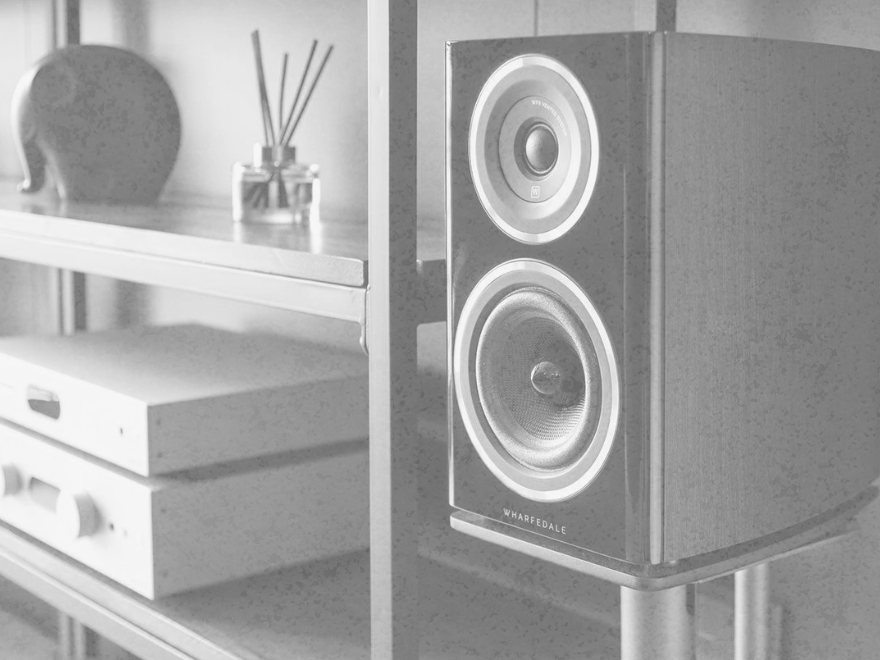Definition of Passive and Active Bookshelf Speakers
Bookshelf speakers are versatile and compact audio systems designed to fit on shelves, desks, or other small spaces. There are two main kinds of these speakers: inactive and active.
The major difference is that active bookshelf speakers have an amplifier built in, while silent bookshelf speakers need an additional external amplifier, or receiver.
Importance of Understanding The Key Differences
It's important to know the differences between inactive and active bookshelf speakers. Then choosing the right pair for your needs, money, and personal tastes, is not over-complicated.
This guide will give you a detailed look at both passive and active bookshelf speakers. We'll talk about their parts, pros and cons, and key differences to help you decide which ones are best for your home audio setup.
Passive Bookshelf Speakers

Basic components
Passive bookshelf speakers consist of the following components:
- Speaker drivers: These are responsible for producing sound, including woofers for low frequencies and tweeters for high frequencies.
- Speaker cabinet: The enclosure that houses the speaker drivers, designed to minimise sound distortion and enhance audio quality.
Amplification
With passive bookshelf speakers, amplification is handled externally:
- External amplifier or receiver required: Passive speakers need a separate amplifier or receiver to power and control them.
- Selecting the right amplifier: It is crucial to select a suitable amplifier that has the correct resistance and wattage, matching the requirements for the passive speakers. Otherwise the speakers can be damaged.
Pros
Passive bookshelf speakers offer the following advantages:
- Flexibility in system configuration: You can mix and match different components to create a personalised audio system.
- Upgradeability: You can easily upgrade individual components within your system, such as the amplifier, speakers, or cables, to improve the overall performance potentially through bi-wiring or bi-amping.
Cons
However, passive bookshelf speakers also have some drawbacks:
- Requires additional components: To create a complete audio system, you'll need to invest in an amplifier or receiver and appropriate cables, which may increase the overall cost.
- Potential for impedance mismatches: Choosing an amplifier with incorrect impedance can lead to suboptimal performance or even damage to the speakers.
Active Bookshelf Speakers

Basic components
Active bookshelf speakers come with the following components:
- Speaker drivers: Similar to passive speakers, active speakers also have woofers and tweeters to produce sound.
- Speaker cabinet: The enclosure for the speaker drivers, optimised for sound quality and minimal distortion.
- Built-in amplifier: Active speakers include an internal amplifier specifically designed for their drivers.
Amplification
With active bookshelf speakers, amplification is handled internally:
- Internal amplification tailored to the speaker: The built-in amplifier is optimised for the speaker's drivers, resulting in better synergy and sound quality.
- Active crossover network: Active speakers use an active crossover network, which separates the audio signal into distinct frequency bands before amplification, improving sound quality and reducing distortion.
Pros
Active bookshelf speakers offer the following advantages:
- Simplified setup: With fewer components, active speakers are easier to set up and require less space.
- Optimised sound quality: The built-in amplifier and active crossover network result in better sound quality and amplifier-speaker synergy.
Cons
However, active bookshelf speakers also have some disadvantages:
- Limited upgradeability: Since the amplifier is built-in, upgrading individual components is more challenging, and you may need to replace the entire speaker to improve performance.
- Power requirements: Each active speaker requires its own power source, leading to additional power cables and outlets.
Key Differences Between Passive and Active Bookshelf Speakers
Key Differences |
Passive Bookshelf Speakers |
Active Bookshelf Speakers |
Amplification |
- External amplifier or receiver - Need to match amplifier to speaker |
- Built-in amplifier - Amplifiers designed specifically for drivers |
System complexity |
- More components (amplifiers, cables) - More complex setup |
- Fewer components - Simpler, more straightforward setup |
Sound quality |
- Passive crossover networks - Variable amplifier-speaker synergy |
- Active crossover networks - Optimised amplifier-speaker synergy |
Upgradeability |
- Greater flexibility for upgrading components - Easier improvements |
- Limited upgradeability - Often requires complete speaker replacement |
Amplification
- Internal vs. external: Passive speakers rely on an external amplifier or receiver, while active speakers have built-in amplifiers.
- Matching amplifier to speaker: With passive speakers, you need to choose an appropriate amplifier, while active speakers have amplifiers specifically designed for their drivers.
System complexity
- Number of components: Passive speakers require additional components such as amplifiers and cables, while active speakers have fewer components overall.
- Ease of setup: Active speakers generally offer a simpler and more straightforward setup compared to passive speakers.
Sound quality
- Active crossover networks: Active speakers utilise active crossover networks for improved sound quality, while passive speakers rely on passive crossovers.
- Amplifier-speaker synergy: Active speakers have amplifiers specifically tailored for their drivers, leading to better synergy and sound quality compared to passive speakers.
Upgradeability
- Flexibility of passive systems: Passive speakers offer more flexibility for upgrading individual components, making it easier to improve audio performance over time.
- Limitations of active systems: Active speakers have limited upgradeability since the amplifier is built-in, often requiring a complete speaker replacement for upgrades.
Selecting the Right Bookshelf Speaker for Your Needs
Considerations
When choosing between passive and active bookshelf speakers, consider the following factors:
- Budget: Determine your budget for speakers, amplifiers, and additional components.
- Room size and acoustics: Consider the size of your listening space and its acoustics, as this may affect speaker performance.
- Audio source compatibility: Ensure the speakers you choose are compatible with your preferred or existing setup, such as turntables, streaming devices, or classic CD players.
- Desired sound quality: Consider your personal preferences for sound quality, including factors like bass response, clarity, and imaging.
Recommendations
- When to choose passive bookshelf speakers: Opt for passive speakers if you prefer the flexibility to upgrade individual components, have a specific amplifier in mind, or want to create a more personalised audio system.
- When to choose active bookshelf speakers: Choose active speakers if you value a simpler setup, fewer components, and optimised sound quality with minimal effort.
Conclusion
Understanding the key differences between passive and active bookshelf speakers is important before making a purchase. This includes amplification, system complexity, sound quality, and upgradeability. All these factors are crucial when selecting the right speaker for your home audio setup.
By considering factors like budget, room size, audio source compatibility, and desired sound quality, you can make an informed decision and choose the right bookshelf speaker for your specific needs and preferences.



Share:
The Ultimate Guide to Choosing the Perfect Bookshelf Speakers for Your Home
Bookshelf Speakers vs. Floorstanding Speakers: Which is Right for You?